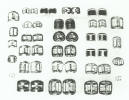
PLATE no. XXVIII
Collection of D. J. Hile, Esq.
No. 163. Collection of shoe buckles of the eighteenth century.
Perhaps the shoe in one form or other is nearly as ancient as the foot. It originally appeared under the name of “sandal.” This was no other than a sole without an upper leather. But, whatever was the cut of the shoe, it always demanded a fastening. Under the house of Plantagenet the shoe shot forward horizontally from the foot to an enormous length, so as to require the extremity to be fastened to the knee, sometimes with a silver chain, at other times with a silk lace, and even with a piece of common pack thread. This enormous beak to the shoe became the subject of legislative enactment, for we find that in 1465 an Order of Council was issued, prohibiting the wearing of shoes whose beaks projected more than two inches in front of the foot on pain of a fine to the king, and even of excommunication. When this fashion changed, the rose shoe-tie sprang up in compliment to the houses of Lancaster and Tudor. This rose in its turn gave way to shoelaces and strings, which were often made of silk, tagged and fringed with silver. At length, in the reign of William and Mary) the shoe buckle made its appearance. This mode of fastening the shoe became very’ generally accepted in foreign countries as well as our own, and the town of Birmingham became celebrated for the large number as well as the excellence of the buckles made there. Seventy years ago the kind of buckle most in demand was made of pinchbeck, an alloy of copper and brass, so called from the name of the person who so employed it. Another variety was the plaited buckle. This was cast in pinchbeck, with the pattern on its surface, and a silver coating was laid on by means of a flux of turpentine and resin, and the surface was finally chased or stamped. A third and more valuable quality was the “close-plated” buckle. A form of buckle extensively made for foreign sale was produced from a compound metal known among the workmen as Tutaunia, and cast in moulds. It is said that in Germany this
(Text missing)